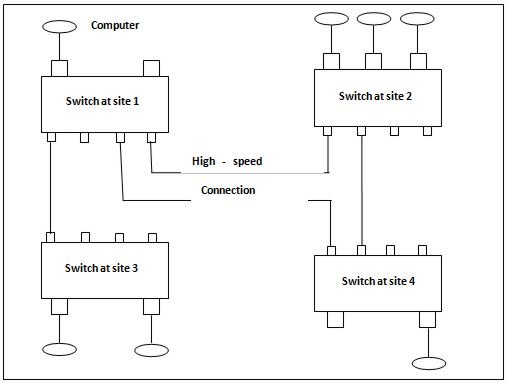wan:- Introduction to wide area network. A Wide area Network (WAN) is best described as a data network that covers a relatively broad geographic distance. Unlike a LAN, which is usually localized within a relatively small area such as a single office, building or small campus, a WAN will typically span distances of anywhere from a few, to thousands of kilometers. Besides distance, LANs and WANs are generally differentiated by network ownership. With a LAN, companies typically own and operate all of the equipment that interconnects devices –switches, routers, wiring, and so forth. This is usually not the case with a WAN, ehere a service provider (such as local telecommunications carrier) generally owns the network links and switching equipment.
Introduction to wide area network (wan)
In order to interconnect geographically dispersed locations, companies will usually provision services from a telecommunications carrier, generally renting or leasing links on a monthly basis. The speed and cost of these links can vary greatly, depending upon bandwidth requirements, distances to be spanned, and available technologies. As a general rule, WANs are implemented at speeds much slower than their LAN counterparts, with higher bandwidth requirements significantly increasing monthly costs.
This is a function of simple economics – providers have made huge investments in building their networks and are doing their best to make money. For companies, choosing the most appropriate WAN technology involves finding a cost-effective solution that meets their performance, reliability, and scalability requirements. To be considered a WAN, a network must be able to connect an arbitrary number of sites across an arbitrary distance, with an arbitrary number of computers at each site. In addition, it must have reasonable performance (no long delays) and allow all of the computers connected to it to communicate simultaneously. This is accomplished with packet switches.

Packet Switches
Packet switches are small computers with CPUs, memory and I/O devices. They move complete packets, using a technique called Store and Forward. An incoming packet is stored in a memory buffer and the CPU is interrupted. The processor examines the packet and forwards it to the appropriate place. This strategy allows the switch to accept multiple packets simultaneously. As the figure above illustrates, WANs the currently do not need to be symmetric.
Forwarding a packet
A data structure contains the information that tells the switch where to send the packet next. This is called a routing table. The destination address in the packet header determines the routing table entry that is used to forward the packet . It could be forwarded to a computer attached to the switch that is examining the packet or it could be to another switch in the WAN. The WAN is a place in the network that aggregates various types, speed and links running a disparate set of protocols together crossing metropolitan, state, and even country boundaries.
The largest example of a WAN is the internet itself, which can be regarded as the public WAN. The primary purpose of a WAN is to connect users and applications connected to various LANs. As evident from its definition, the WAN is the central point for all data aggregation coming from various within an enterprise network. Because of this, it is important to understand not only how a WAN is constructed, but also the underlying business drivers that have been and continue to bring changes to this place in the network. A WAN is a network that covers a broad geographic area and often uses transmission facilities provided by common carriers. WAN technologies function at the lower three layers of the OSI reference model:
- Physical Layer (L 1)
- Data Link layer (L 2)
- Network layer (L3)
I hope that you understand my post. if you like this post then share my post, and comment on my post if you have any suggestion or Queries related wide area network. Thank you!




